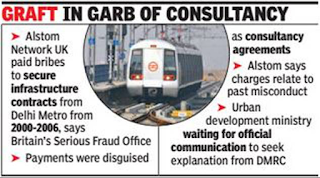One of
the more alarming items to have been dug up by the Brazilian press as it
investigated the price fixing scandal which pointed the finger Alstom's
transport and power divisions, was a three-page document that apparently acted
as in-house guide to the company's employees and third-party agents on "how to bribe". [Note for users: use Google Chrome with the Google-translate extension
enable - that way the Portuguese article will automatically appear in English.
Kind of helps! Sorry IE users - Bing translator is decidedly inferior]. One of Alstom's commercial team in Brazil,
André Botto told one of the investigating judges that the commission
rate (bribe rate) was 15%, with half going to the decision makers
(politicians and senior executives of the purchaser) and half to the agent.
The
internal document, which soon became known as the "how to bribe
guide", was apparently was created in 1997 when another key Alstom
character was in charge of corporate ethics.
Bruno Kaelin was the group's head
of compliance (see para
16 in the WSJ article of 2008) immediately prior to Jean-Daniel Lainé, who
I mentioned in the last Alstom entry. Mr Kaelin was in residence, as it were,
when the "How to Bribe" document was initially circulated. Mr Kaelin
was also a
director of Alstom Network UK (or Alstom International Ltd) as it was then
known, between January of 2001 and his group resignation in December 2005. In
both the Swiss and the UK companies he was replaced upon resignation by Jean-Daniel Lainé as the new global head of
Compliance and Ethics.
According
to the Swiss Punishment Order, Alstom
restructured its global network of third-party agents and the corporate
structure via which they were remunerated (see clauses 2 and 3). It is
important to understand that this is not some journalistic conjecture; it is a
Swiss judicial finding, which is to say that it is verified information. Two companies were "founded to
centralize the execution of compliance procedure and payments": Alstom
Network Schweiz AG and Alstom Network UK Ltd. To be accurate, two existing
Alstom group companies were re-named and their responsibilities amplified to
make them respectively the payment hubs for power and transport. Whilst Kaelin
left Alstom in 2005, it should be noted that Lainé was in charge of compliance
for the power group (2003-05) prior to taking on the global role on Jan 1st
2006.
The
"how to bribe guide" had five sections (see
paragraph 2 here) that covered the basic objective (practical guide to
paying third-party commissions, the need to keep the information from being
discovered, to keep it off the tax-books, to ensure that the work undertaken
was "consulting and support" and to have the papers signed by the
contracted company's CFO.
 |
| Times of India Sept 2014 |
Indian
press reports that extradition
orders had been sent by the UK authorities to Switzerland for Bruno Kaelin
and France for Graham Hill: both are thought to be in poor health, and I note
that Mr Kaelin's name has been dropped from the SFO's suit.
Whilst the SFO's case against Alstom Transport UK
focussed on issues in Poland, Tunisia, India and Hungary, the implication of
the Swiss sentencing ties the company to all of the Brazilian transport
corruption cases.


No comments:
Post a Comment